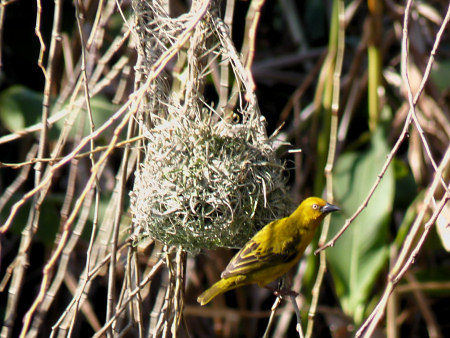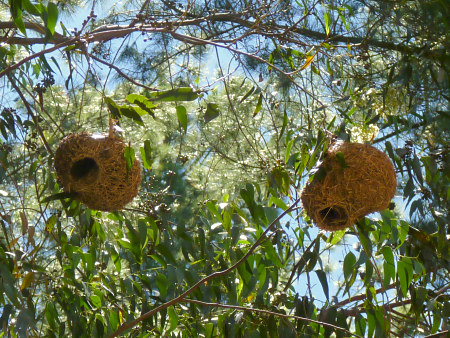This is the tenth post in my monthly series on the fascinating nature I encounter here in South Africa.
Today I’m going to show you a very special type of bird, and one with a crafty connection! Weaver birds are found throughout Africa, and what makes them special is that the males weave an intricate nest to impress the females. Each species of weaver has different colouring and also builds a differently-shaped nest – isn’t that cool? In my area, we can see two types of weaver (Cape and Southern Masked).
This is a male Cape Weaver (Ploceus capensis). He’s in breeding plumage, with a reddish cast around his face:

The male weaver picks grasses and begins to weave them together around a hanging tree branch, usually over water:

He continues until he completes a beautifully-woven nest, with the opening at the bottom for security:

If a female is impressed with his nest-building skills, she moves in and lines the nest with softer grasses and feathers:

After a couple of days, the grasses turn brown and, if the nest is still empty, the poor male has to start building another nest to try again. But don’t feel too sorry for him – he’ll build more nests either way, and can have several breeding females in his flock!
These Cape Weaver nests were high in a tree, and not over water, so I could get a shot from below. From this angle, you can see the beautiful shape of the nest, with a short off-centre entrance tunnel:

This is a male Southern Masked Weaver (Ploceus velatus):

Their nest shape is different – more pointed at the top and with just a hole at the bottom (no entrance tunnel):

Here’s a fallen nest so you can see the inside and the beautiful craftsmanship!

As the weavers usually like to nest over water, we see them by the river near our house, and near ponds and lakes when we’re out adventuring. But I didn’t realise that weavers eat seed, so, when I put up a seed feeder at Christmas (in the hope of seeing a canary or other type of wild finch), we got a lovely surprise – weavers in our own garden!
Male Cape weaver:

I thought this was a pair of Southern Masked Weavers, but, looking closely, I see the female is actually a Cape Weaver. (The females look quite similar, but the Cape has a longer, pointier beak and the Masked has a whiter tummy and red eyes):

And, best of all, fledged babies in our garden! I’m reasonably sure these are a pair of baby Southern Masked Weavers:

(By the way, I’ve just discovered that the tree with the wicked-looking thorns the babies are sitting on here is a Bougainvillea. I’ll have to remember to take a photo when it’s in full bloom – it’s stunning!)
Aren’t the weavers amazing? It was hard narrowing down my pics to just these few – weavers are so interesting, I seem to have taken a couple of hundred photos of them, but I think these selections have captured the essence of weaver-ness for you 🙂
I hope you’ve enjoyed this month’s photos – I know I’ve enjoyed sharing them with you! Please leave me a comment if you liked them.
















Anastacia said
beautiful photos, as always June!
Mutant Supermodel said
Bougainvilleas are like the official plant of MIami, Florida. They are everywhere down here so we take them for granted. They are really splashy though and come in lots of colors.
June said
The funny part is that it’s taken me the best part of a year to identify it! I assumed that all the plants I encountered here would be native, so I scoured my nature books looking for a large African plant with huge thorns and bright bracts around the flowers, with no luck! I’ve never lived in a sub-tropical climate before, so, although I’ve heard of a bougainvillea, I had no idea what they looked like. Eventually I figured it out with a google image search for “thorn bract” – guess what the first result was 😉
Simone said
Impressive! Imagine this perfectly shaped nest was prepared with a beak only, no hands or fingers to help. Awesome!
Thank you for sharing!
Loulou said
Your pictures are beautiful and the topic so interesting. One of the beauties of the blog world is to see things people from other places see, such as these lovely birds.
Chelita said
What industrious little fellows! 🙂
Judy Carlson said
Awesome birds and nests! Please keep posting about wildlife!
Meg P said
You have just made English teachers very happy! Do you know the poem “The Weaver Bird”? Now we can show our students what they look like up close — thanks, June!
Janine said
That is so neat! Reminds me of The Life of Birds with David Attenborough (best wildlife series I’ve seen yet). Lovely photos too, thanks for sharing them with us! 🙂
Mia said
Wow! Thanks sooooo much for sharing these pictures and information. How neat to see.
CrochetBlogger said
That close up of the fallen nest really shows off the bird’s crafty skills! Awesome.
Monica said
Crafters in your own back yard! So cool! Very educational! Thanks for sharing! The Weavers are very talented, those nests look like woven baskets! I wonder if they helped to inspire basket weaving? I may have to do more research! 😀 Thanks June!
Joanne Klauber said
Lovely and fascinating photos, June! Thank you for sharing!